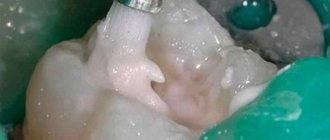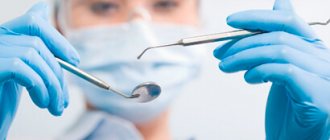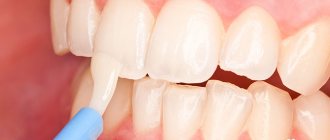720
Endodontic treatment of a tooth involves invading its internal cavities - the pulp chamber and root canals for treatment (vitalization) or removal of the pulp.
The location of the opening may be the bottom of the carious cavity or the undamaged, intact surface of the tooth.
The essence and purpose of manipulation
Tooth trephination (Greek Trypanon - trephine, drill) is the initial stage of endodontic treatment, which involves opening the top of the pulpous chamber, removing the pulp located in the coronal part, and creating access to the mouths of the tooth root canals.
This procedure is also called “crown expansion” or “endodontic coronal preparation.”
It should be noted that trephination does not involve expanding or changing the shape of the dental cavity and penetrating the tooth canals. Its more modest task is to open the crown cavity and provide access to the mouth of the root canals. The operation can be performed on both natural and artificial crowns.
According to the general medical classification, trephination is indicated by code A 16. 07. 092, where “A” means medical, indicating that this is a surgical intervention, “07” - that it is carried out in the oral cavity, and “092” indicates that this the procedure, in fact, is trepanation.
When is it prescribed?
This manipulation is indicated in cases where it is necessary to gain access to the internal tissues of the tooth. Most often used if:
- diagnosed with pulpitis (chronic/acute), periodontitis;
- the carious cavity is connected by a passage to the pulp chamber or the septum between them is too thin.
The doctor will refuse to open the crown if the tooth root is fractured or, during an x-ray, the dentist discovered that the root canals are curved.
The discovered contraindications for endodontic coronal preparation are a direct indication for extraction of the problematic unit of the row.
Indications
Trephination is the first stage of endodontic treatment; it is indicated in all cases where it is necessary to penetrate inside the tooth for its treatment (vitalization or pulp removal, obturation of dental canals, installation of a pin or other operations).
Most often, trepanation is performed in the following cases.
- The presence of a deep carious cavity in the area of the clinical crown of the tooth with a thin or completely absent septum between it and the pulpous chamber.
Even if the thin wall is preserved, it is capable of allowing pathogenic microorganisms to pass through, resulting in possible infection of the pulp. Therefore, if appropriate symptoms are present, the doctor may consider trepanation of the tooth necessary. - Chronic or acute pulpitis.
- Any form of periodontitis.
A contraindication to trepanation is the impossibility of restoring the functionality of the tooth and the need for its removal:
- impassable, curved root canals;
- severe periodontal damage;
- tooth root fracture.
In all these cases, the tooth is simply removed.
Why does a tooth hurt when you press it, and what to do in such a situation.
Visit here to learn more about the signs of dental pulp necrosis.
At this address we will tell you whether garlic works against toothache.
Indications and contraindications for the procedure
There are always very serious indications for trephination of a dental cavity. Most often this is the presence of a large carious cavity. The procedure is recommended when the wall separating the carious process from the pulp chamber is very thin, or when it is completely absent.
The initial stage of endodontic treatment with trepanation must also be carried out if the patient is diagnosed with pulpitis or periodontitis1.
The procedure is not always advisable. The following reasons are contraindications to it: root fracture, obstruction and severe curvature of the root canals. In these cases, doctors recommend removing the “causal” tooth.
The word “trepanation” comes from the Latin trepanatio, which means “surgical manipulation to create an opening, the purpose of which is to penetrate to the source of infection or inflammation.”
Preparatory stage
Trepanation should be preceded by a diagnosis, a complete assessment of the condition of the crown of the tooth, its roots, and periodontal tissues.
To achieve this, the following activities are carried out:
- Questioning the patient regarding complaints. Inspection and probing of the tooth to determine the presence and depth of carious cavities in the clinical crown. Assessing the condition of the gums in the area of the problem tooth. If there are fillings, their condition is assessed.
- Electroodontometry. Determination of the condition of the pulp by its reaction to electric current.
- X-ray of the tooth. This is a mandatory and very important stage in endodontic treatment.
Using fluoroscopy, the number and condition of root canals, their length, and anatomical shape are determined. The shape and dimensions of the pulp chamber, the thickness of its walls and lid are established. The presence of lateral canals, pathological changes in the tooth ligament.
By applying the bur to the radiograph, the required size of the instrument and its correct direction when opening the tooth are determined.
Before treatment, professional cleaning of the entire dental cavity or just a segment of the jaw arch with the element being prepared may be necessary.
Cost of tooth root resection
The price of root resection is determined depending on the volume of surgical intervention, the cost of consumables, and anesthesia. The result of the procedure fully justifies the money spent. After all, it is cheaper than removal with further implantation and prosthetics. The doctor will tell you exactly how much tooth resection costs after examination and diagnosis.
Sequence of doctor's actions
Trepanation involves three main stages:
- local anesthesia;
- tooth isolation by applying a rubber dam;
- directly opening the crown.
After anesthesia and the application of a rubber dam, the doctor proceeds directly to trepanation. The preparation is performed using a turbine drill with a diamond or carbide bur with a supply of coolant.
First, the crown is opened - installed by drilling a point connection between the bottom of the carious cavity or the intact surface of the tooth with its internal cavity.
Then the coronal cavity is opened - the edges of the enamel-dentin cap overhanging it are removed. Dentin sawdust and necrotic tissue are washed off with liquid.
The coronal part of the pulp is removed with a sharp excavator and EDTA (sodium salt dihydrate, which softens surface dentin) and disinfectant sodium hypochlorite are supplied into the cavity.
The walls of the cavity and the mouth of the dental canals are not additionally prepared. The main thing is that they are clearly visible and access to the dental canals is provided.
At this point, the trephination of the tooth ends and the next stage of endodontic treatment begins according to indications.
In the video, watch the process of tooth trephination.
Preparation for the procedure is a mandatory stage
According to the medical classification, trephination of the tooth crown is a type of surgical intervention that is performed in the oral cavity. It requires careful preparation, in particular, x-ray diagnostics. Using X-rays, the doctor assesses the condition of the canals, their number, size and shape. In addition, the images allow you to study the features of the pulp chamber. Based on this data, the specialist selects the required tool size.
Before this important manipulation, experienced doctors insist on sanitization and professional oral hygiene so that during the treatment process bacteria do not penetrate into the open cavity, which can nullify all efforts.
“Three times in my life I had to treat pulpitis - I never knew about this procedure. And then one day a doctor at an appointment with me, smiling so sarcastically, said that now we will do trepanation of the tooth! My eyes popped out of my sockets, it’s an unpleasant association; before that, I’d only heard about craniotomy, to be honest!”
[email protected] , review from otzovik.com
Some nuances
The starting point for opening the pulpous chamber should be located at the bottom of the caries lesion or on the intact surface of the tooth closest to the pulp, that is, at the site of the pulp horn. The moment the drill enters the cavity manifests itself as a feeling of “sinking” of the instrument.
When is a rubber dam applied?
There is no consensus. Some experts recommend doing this before opening the cavity, others - after opening. The latter explain their choice by the fact that the absence of a rubber dam at the stage of opening the cavity helps to more accurately guide the tool.
Trepanation technique
Trephination methods vary somewhat depending on the group of teeth and their location (upper or lower jaw).
Technique for preparing incisors and canines
The carious cavity on the cutting surfaces of the incisors and canines is transferred to the lingual/palatal surface, and only then the pulpous chamber is opened.
Preparation of intact incisors and canines begins from their lingual/palatal surface - from its central point. Preparation from the cutting edge can lead to destruction (breakage) of the lateral surface of the incisor or canine. The intact incisors are exposed in the area of the blind fossa.
During trephination, the instrument is first directed perpendicular to the palatal or lingual surface of the canine or incisor. After the hole is formed, the drilling direction is changed to parallel to the longitudinal axis of the tooth.
Trepanation of premolars
In premolars, carious cavities begin to be opened from their bottom in the place closest to the pulp. In this case, they try to transfer the preparation to the chewing surface.
The opening point for intact premolars should be located on the occlusal surface in the middle of the fissures. When drilling, the bur is directed towards the most pronounced tubercle.
The dental cavity should be opened in the palatal-buccal direction. Doing this in a mesial or distal direction is not recommended, since this quite often leads to perforation of the walls of the coronal cavity.
The opened cavity should have a round or oval shape.
Molar preparation
Carious cavities in the molars of the upper jaw are trepanned in the same way as premolars. During opening, the bur is directed in the palatal-buccal direction.
Lower intact molars have their own opening characteristics. The bur entry point should be located in the middle of the longitudinal fissure. The instrument is directed towards the anterior buccal cusp. Unlike maxillary painters, the cavities open in the mesial-distal direction. Buccolingual opening is considered faulty.
The second and third maxillary molars are the most difficult for trephination due to the different structures of their crowns.
Difficulty identifying canal mouths
If the orifices of the root canals are poorly identified, their location is established using a dye that colors the entrances to the canal dark blue.
What is the danger of chronic caries and its treatment tactics.
In this publication you will find instructions for using a caries marker.
Here is all the most important information about fissure caries.
Intervention algorithm
The procedure is carried out in stages:
- local anesthesia;
- using a rubber dam to isolate the element to be opened;
- trephination with a burr machine.
For opening, tools made of diamond or carbide boron are used. During operation, periodic supply of chilled water is required.
Before destroying the partition between the pulp chamber and the coronal part, the dentist drills a point with a drill, gradually boring it out in width in a circular motion. Destroyed dentin particles are washed away with water.
Important! To soften dentin tissue, sodium salt dihydrate is used - a solution that helps destroy hard dentin.
The opening technique varies depending on which unit is being trepanned.
Features of preparation of all types of teeth
The canines and incisors are opened from the point of the palatal surface, and then the dentist clears the carious cavity and opens the pulp chamber. The cutting part of the frontal units should not be the basis for trephination, as this will lead to the tooth breaking off from the side.
The premolars are opened starting from the bottom, at the point closest to the pulp. By opening the premolar, the doctor makes an oval or round hole, which will help to carry out the filling more efficiently.
Creating access to the chamber in the molar is identical to the algorithm for trephination of premolars. Dentists believe that the most difficult pulp to open is in the second and third molars. This is due to the structural features of the coronal part of the units.
Complications
Most often, dentists and patients encounter the following complications after dental trephination:
- perforation of the wall of the chamber with the pulp (more often occurs due to the fault of the doctor who works with the equipment carelessly and does not know the intricacies of the structure of dental tissues well enough);
- damage to the instrument (poor quality equipment, excessive pressure during operation, destroyed coronal part of the dentition element);
- change in enamel color (if the resulting cavity is improperly processed from the inside or violation of the autopsy rules leads to a change in the color of the tooth to gray or gray-yellow);
- pain (if the dentist neglects the rules of the operation, does not apply cooling or performs poor antiseptic treatment).
To summarize, we note that most often complications occur due to the fault of the dentist, who ignores the manipulation protocols, does not conduct additional examinations and neglects cooling during drilling. Therefore, we advise you to carefully consider your choice of dentist and contact exclusively highly professional doctors.
Possible complications
Coronal preparation is less risky in terms of complications than root preparation. However, they still happen:
- Perforation of the wall of the pulpous chamber. The reason is the carelessness of the dentist, the wrong choice of instrument, the lack of an x-ray, which determines the shape of the cavity.
If the hole is small and the perforation site is located above the periodontal groove, the defect can be easily eliminated - with the help of cement.If the hole is larger than 1.5 mm, and the perforation is located below the periodontal groove, there is a risk of filling material leaking into the periodontium, which can lead to inflammation.
- Broken tool. Occurs due to excessive application of force, the use of low-quality instruments, poor condition of the crown, and the doctor ignoring the shape of the cavity.
- Change in color (darkening) of the crown . The reasons are a violation of the operating mode of the tool (high speed, lack of cooling), improper processing of the cavity walls.
- Pain. They may appear after the instrument enters the periodontium, when working without cooling, or due to poor-quality antiseptic treatment (re-infection).
In general, complications are caused by preparation errors, lack of cooling, incorrect choice of instrument, and lack of high-quality x-rays. To avoid them, you need to strictly follow the operation protocol.
Types of dental trauma
Let’s take a closer look at how one type of dental injury differs from another and how to treat them.
Bruised tooth
When a tooth is bruised, its position in the alveolus (tooth socket) and in the dentition does not change, but swelling of the tissues surrounding it, in particular the gums, is observed. In the first hours after a bruise, continuous painful sensations occur, which intensify when eating or closing the jaws. Sometimes, when a tooth is bruised, a vascular bundle ruptures, and then bleeding begins into the pulp. Diagnosis of a bruise is carried out on the basis of an examination of the oral cavity and an x-ray. Diagnosis of a bruise can be carried out even three days after a dental injury.
Treatment of a tooth bruise consists of creating conditions that would allow the tooth to remain at rest. Solid foods are excluded from the diet.
If, due to a bruise, irreversible damage to the coronal part of the tooth is diagnosed, then trepanation of the crown is performed. The dead pulp is removed and the canal is filled. Before filling, the crown is sometimes bleached (if it begins to darken after a bruise).
In any case, if you suffer a dental injury, you should contact your dentist. You definitely need a diagnosis and a photo of the tooth roots. Externally imperceptible changes during an injury inside can be expressed by a crack in the root of the tooth. This disruption will cause air accumulation and inflammation. Therefore, if your tooth is currently injured, make an appointment with the dentist by calling 8 (495) 033-00-63 or leaving your details in the online appointment form. Tell the administrator about your problem, they will make an appointment with an experienced doctor who will prescribe the correct diagnosis of the oral cavity after a dental injury.
Tooth luxation
The displacement of a tooth in the alveolus under the influence of rough, heavy mechanical force is called tooth luxation. Tooth dislocation occurs more often if the bone tissue is weakened. Then the tooth in the alveolus can be “moved from its place” even while eating heavy food. Damage to the integrity of the gum tissue is often observed when a tooth is dislocated.
Tooth dislocation can be either isolated or associated with a fracture of the dental roots, alveolar process, or even the jaw bone itself. In dentistry, tooth luxation is divided into three subtypes:
- complete dislocation - the tooth falls out of the alveolus;
- incomplete luxation - the tooth changes position in the dentition and in the alveolus, this subtype is accompanied by rupture of periodontal tissue;
- “impacted” dislocation - the tooth moves “inward” into the body of the jaw itself, destroying bone tissue.
Tooth dislocation is accompanied by severe pain in a specific tooth and even in the entire dentition, as well as mobility of damaged teeth.
Treatment for a luxated tooth is based on deciding whether it is advisable to save the damaged tooth. The criterion for making a decision is the condition of the bone tissue of the tooth. It is advisable to leave the tooth if at least half of the tooth root remains intact.
If the tooth has not fallen out of the alveolus, but has changed its position relative to the socket and other teeth, then it must first be placed in its original place (the procedure is carried out under local anesthesia). Then, with the help of special structures, even slight tooth mobility is eliminated.
In some cases of tooth dislocation, the neurovascular bundle ruptures. If this happens, the pulp is removed, then the root canal is filled. The condition of the pulp is determined by its reaction to the action of electric current. If the pulp reacts to a small charge, then it is not damaged. Most often, in order to avoid errors, current research is carried out twice, with a short break. The pulp, especially in cases of “impacted” dislocation, must be removed as early as possible to avoid the development of dental diseases.
If a complete dislocation occurs and the tooth falls out, then a tooth replantation procedure occurs. It is effective if the periodontal tissue is not damaged. First, trephination of the tooth is performed, pulp is removed and the canal is filled. Then, after treating both the tooth root and the alveoli with antiseptics, the tooth is inserted into its original place and fixed with special structures. The tooth is constantly examined and periodically radiographically monitored. The replantation procedure should be carried out a maximum of thirty minutes after the tooth falls out of the socket. Replantation at other times may not be effective.
Tooth fracture
A tooth fracture is a fracture of the crown part of a tooth due to mechanical impact. Crown restoration occurs using composite materials, inlays, and metal ceramics, which is not particularly difficult.
It is much more dangerous if the pulp was affected when the tooth was fractured. Such dental injuries lead to depulpation, canal filling and restoration of the crown shape.
If the crown is completely broken, the doctor decides to restore it with a root pin and an artificial crown. In such cases, filling the canal is mandatory.
Tooth root fracture
A tooth root fracture is much more difficult to treat than a crown fracture. There are several subtypes of dental root fracture:
- longitudinal;
- oblique;
- transverse;
- splintered.
All root fractures, except transverse ones, end with tooth extraction. With such fractures, the remaining part of the tooth root cannot be used as a support for the tooth.
Transverse fractures that occur mid-root or above can be treated. The root fragments are connected using pins, placing them in the correct position. The root canals undergo full treatment.
Restoration of the broken part of the tooth must be carried out immediately in the coming days after the injury. When closing the jaws and eating food, the broken tooth moves and the adjacent teeth tilt towards the damage, which significantly complicates the treatment and reduces its further effectiveness.
Remember that the main principle that will help you avoid dental injury is safety, and the main criterion for treating dental injuries is timeliness. Take care of your teeth, take care of the condition of your oral cavity and do not neglect the advice of dentists.
Reviews
The vast majority of visitors to dental offices are familiar with tooth trephination, which everyone simply calls “drilling.”
If you are one of them, and some special incident happened to you during tooth trephination, share your experience with other visitors to our site. You can do this by filling out the form at the bottom of this page.
If you find an error, please select a piece of text and press Ctrl+Enter.
Tags toothache
Did you like the article? stay tuned
Previous article
In what cases are braces + springs used and how effective?
Next article
What you need to know about supraocclusion
Symptoms, types of disease
Common signs of dental periodontal inflammation are the following:
- acute pain, often throbbing, which intensifies when you touch the sore tooth;
- swelling of the gums, cheeks, and sometimes lips;
- redness of the oral mucosa;
- bleeding gums;
- darkening of the tooth;
- increased body temperature;
- bad breath.
If periodontitis is serous, it means that the disease is at its initial stage. In the absence of timely treatment, the purulent stage of the disease may begin, which is also accompanied by such sensations and conditions as “an overgrown tooth” (occurs due to the accumulation of purulent exudate), enlarged lymph nodes, swelling, increasing tooth mobility and an increase in the number of leukocytes in the blood.
Dental canals are used to remove pus. If it is impossible to carry out such a procedure, as well as if the tooth is highly mobile, a gum incision or tooth extraction may be prescribed. When periodontitis becomes chronic, acute pain may not be observed. Among the symptoms of the acute course of the disease are the following: loss of fillings, increased tooth mobility, and formation of interdental gaps. An accurate diagnosis in the chronic form of the disease helps to make an x-ray of the tooth, which shows granuloma and destroyed tissue.
Cost of periodontitis treatment
The price for treatment of periodontitis in a dental clinic will depend on the area and degree of damage (fibrous, granulosa or granulomatous periodontitis), the general price level in a particular medical institution and the number of visits to the doctor that will be needed to carry out the planned course. Typically, the cost of treatment is also directly dependent on the number of tooth canals: for single-canal – 5,000-10,000 rubles, two-canal – 6,000-12,000 rubles, three-canal – 8,000-20,000 rubles.
Treatment of periodontitis, gum incision and antibiotics
Among the measures aimed at diagnosing periodontitis with its subsequent treatment, there may be the following procedures:
- dental x-ray;
- administration of local anesthesia;
- removal of destroyed tissue, stone overhangs, inflamed pulp (cystectomy);
- coronoradicular separation, that is, dissection of the tooth;
- unsealing, straightening channels (giving them a conical shape), measuring their depth with subsequent mechanical processing;
- antiseptication of the canals using cotton swabs and chlorine or other antiseptics (the dentist can also leave the disinfectant in the canals for a while, covering it on top with a temporary filling or hermetic bandage);
- installation of a permanent filling.
Treatment of different stages of the disease can be done therapeutically or surgically. In some cases, the patient is also asked to undergo physical therapy, which consists of the use of magnetic therapy, UHF, electrophoresis, laser therapy, and paraffin baths.
If the nature of the development of the disease is such that the natural canal of the tooth is not enough to drain the resulting pus and other fluids, surgical intervention is prescribed - an incision in the gums (gingivotomy) to perform resection of the apex of the tooth root. Gingivotomy is used if the gum pocket is too narrow for further treatment or the patient has developed a periodontal abscess.
If the dentist considers it advisable to take measures to stop the destructive processes occurring in the cavity formed near the roots of the tooth, antibiotics are prescribed. Among the drugs used after pulp removal and root canal filling, a course of antibiotics is prescribed, such as Augmentin, Ciprofloxocin, instead of the classic Lincomycin for dental practice, which has too narrow a spectrum of action.











